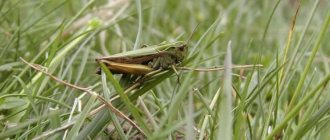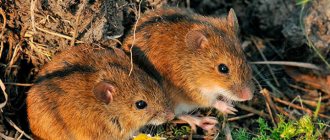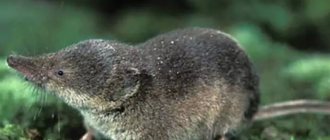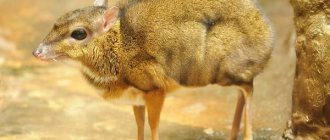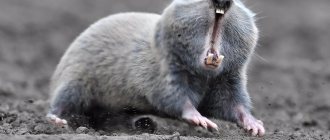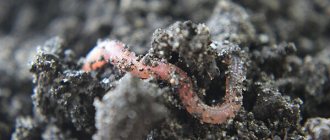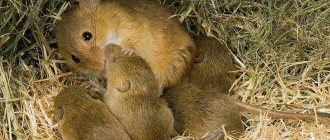Appearance description
The behavior and appearance of the mole have not been studied in as much detail as we would like. The fact is that the mammal chooses hard-to-reach places to live. But still, biologists were able to track this animal in the wild.
It is in appearance that the relative nature of the mole’s adaptability to life underground is revealed. The animal has strong front legs, which allow it to constantly dig the ground. The rounded hands resemble oars in appearance, and the wide palms are turned outward. The fingers are spread apart and end in long, strong claws.
The hind legs are not so strong; with them the mole only scrapes loose soil out of the hole. A long muzzle with an elongated nose helps the animal find food and safe places by smell. The body is covered with a short fur coat, which does not interfere with movement through narrow underground passages.
The wool grows upward and can bend in any direction. The common mole is black-brown or dark gray in color. The mammal has eyes, but they only distinguish between light and darkness. The animals are practically blind, although they do not need vision underground. The structure of the eyeball of moles differs from the organs of other animals . They do not have a lens or retina . Movable eyelids and thick fur protect the eyes from soil getting into them. Mammals have a well-developed sense of smell.
Animal species
In total, about 40 species of moles are known. Some of them are quite common, others are very rare. They differ in appearance, habitat and behavioral characteristics. Main types:
- European or ordinary;
- Japanese shrew;
- American;
- Siberian;
- Caucasian;
- Ussuri mogera;
- star-nosed
The first species of animal is found in Europe, which is why it received its name. The common mole grows small: body length - 16 cm, weight - no more than 100 g. The Japanese shrew mammal is even smaller, and it is found on the islands of Shikoku, Tsushima, Honshu and Dogo. On the mole's muzzle there is a long proboscis with hairs that capture air vibrations. In search of food, the shrew can climb bushes and trees.
The American mole lives in Canada and the USA. These are black and gray animals with thick fur. The length of their tail sometimes exceeds the size of their body. The animal swims well and can climb trees. The description of such a mammal is similar to the Japanese shrew; biologists consider them to be related species.
The Siberian or Altai mole resembles the European one. But females are very different from males. The round body of males reaches 20 cm in length, they weigh only 150 g, and females grow smaller. Males are usually black or brown, females are gray. This species has no ears at all, but the nose has turned into an elongated proboscis.
The Caucasian mole's eyes are covered with a film. But it has a more subtle sense of smell than other species. The black, silky coat fades with age. The mole, which is called the Ussuri mogera, looks very interesting. This is a large animal compared to its other relatives: body length - 21 cm, body weight - up to 300 g. This mole has underdeveloped eyes, and it is a rare species, therefore measures have been taken to protect it in the Far East, Korea and China.
The North American star-nosed bat or star-nosed fish is so named because of its unusual nose. This part of the body consists of many tentacles, each of them has olfactory receptors. The animal loves water very much and often lives near bodies of water. He swims well and can dive.
Main varieties
The classification of moles implies the existence of over 40 species. Among them, the most common are about one and a half dozen subspecies.
East Asian
Animals from the Mole family. They are found in mid-mountain meadows and forests of East and Southeast Asia. Little studied, do not have well described characteristics.
Mogers
Moles with a body length of 9–25 cm and a weight of 290–300 grams. They differ from their relatives of other species in their brownish-brown hair, the specific structure of the auditory apparatus and pelvic bones. There is no fang in the lower jaw. The eyes are covered with leathery membranes and are not visible from the outside.
Ordinary
The animal is known as the European mole. It has a rounded oblong body, an elongated muzzle and a short neck. The limbs are small, adapted for digging. The front legs end in spade-shaped palms that are turned outward. They have powerful claws.
The eyes are partially covered with skin. The hairline is thick and short. This genus is most common in the Mole family.
American shrew
The most popular species of mole in North America. Their habitat is wet areas. They have soft and dense fur. The tail is long, equal to half the body. The length of the animal itself is about 10 cm, weight – 10 grams. The eyes are small, the paws are less adapted to digging than those of other subspecies. The animal can swim and climb bushes.
Hairy-tailed
Another American-Canadian species of moles. The animals weigh 50 g and have a body length of 3.5 cm. The head is strongly elongated. The upper incisors are better developed than the other teeth. The animal sometimes crawls out to the surface of the ground at night.
Whitetail
A representative of Moles, distinguished by its white tail. In general, it looks almost like all other moles. Found throughout Bangladesh, India, China and Myanmar.
Eastern American
A large mole, 16 cm long and weighing 75 g. The front legs are wide and powerful, well suited for digging. There is no hair on the paws. Their width is greater than their length, the hind and front toes are fused.
Western Chinese
The most original type of mole in China. It lives in the provinces of Gansu, Qinghai, Shaanxi and Sichuan.
Habitat
The mole spends almost its entire life in underground burrows, but not every soil is suitable for it. The animal carefully chooses its place. It prefers moist and loose soil. Another habitat is simply not suitable for the mole: it will not be able to break solid lumps of earth.
But sometimes soil mounds are found in fields and meadows. The mammal usually throws excess soil upward. Mole rats can be active both at night and during the day. They don't care what time of day it is, since their eyes don't distinguish between darkness and light well.
The biological rhythms of the mole are different from other animals. The mammal alternates periods of activity and rest. It prefers to work for four hours and then sleep for three. It is not easy for a mole to move underground, so it does not make long movements. Only on hot summer days does the animal break through passages to reservoirs.
Mammals do not like to be in the company of their own kind. These are loners, so they are ready to defend their chosen areas. Moles have a difficult character and often show aggression. If they had to share the land with neighbors, then the passages are dug so that they do not intersect with the paths of another individual. But if one animal dies, the second tries to quickly occupy its territory. As a mark, moles secrete a special substance - a secretion with a pungent odor.
Mammals do not hibernate in winter. The inhabitants of the underworld prefer to spend their time differently during the cold season. They dig deep holes and fill them with supplies. Only underground can moles spend the winter while remaining safe. If they get to the surface, they will become prey for eagle owls, foxes and martens.
Interesting Facts
Moles are unique and amazing creatures in their own way. But it is not recommended to have an unusual animal at home. Because not every professional can create conditions for a comfortable life.
Many interesting facts are known about moles, however, they are considered an incompletely studied species. This is due to their specific habitat.
Interesting Facts:
- Moles, like all underground inhabitants, are very sensitive to vibration. Their behavior can predict disasters such as earthquakes, volcanic eruptions and landslides. In general, everything that is connected with the movement of the earth's layers.
- Molehill soil is an excellent source of fertile soil for garden beds. It does not need to be sifted, it is airy and loose.
- Some Danish archaeological scientists use moles in excavations. Small and very hardworking creatures push to the surface everything that prevents them from digging a tunnel. Including archaeological finds.
- The word "mole" is used to describe secret agents in intelligence organizations. People of this profession, like moles, must have the ability to quietly infiltrate any structure.
- Dirt and dust do not stick to mole fur. It is enough for the animal to shake itself off to get rid of small debris.
- In the cartoon “Thumbelina,” the old mole took his bride to the storerooms with a large supply of food. In real life, moles are indeed famous for their thriftiness. Their tunnels are used for food storage.
- Mole passages lie at shallow depths, but can be from 100 to 200 meters in length, which is several hundred times greater than the size of the animal itself.
- There is a bone in the external genitalia of males.
- Moles do not hibernate, but since it is very difficult to find food in cold weather, they make impressive reserves.
- Contrary to myths and rumors, all moles have eyes. It’s just that in some animals they are located under the skin and are visible only on x-rays. In most cases, the small eyes are hidden behind small slits in the skin or eyelid.
- Like all small animals, moles have an increased metabolism. Therefore, animals must eat almost constantly. An adult animal can eat an amount of food equal to its own weight per day.
- The animals do not live in captivity and are not tamed. At one time they tried to breed them to obtain soft skins, but the idea quickly failed.
- In the USSR, moles were hunted for their skins. Every year the population decreased by several million individuals. Currently, mole hunting is prohibited.
- In loose soil, a mole can dig a meter-long tunnel in 3–5 minutes.
- According to statistics, moles destroy about 1% of crops worldwide. Basically, they do not eat plants, but their active underground activity leads to damage to roots and death of crops.
- A mole's mouth has more teeth than a human's. Depending on the variety, the number of teeth can be from 34 to 44 pieces.
- Moles molt 3-4 times a year.
- In addition to the main food pantries, each mole has an additional warehouse in case something happens to the main one.
- Moles see practically nothing. But animals have very sensitive hearing and a well-developed sense of smell.
- Some moles are excellent swimmers and can even swim across a stormy stream. And such a species as the starfish is capable of diving and preying on underwater inhabitants.
- On occasion, moles may dine on a small mammal or bird.
- Moles' fur grows straight up without tilting. But each hair has a constriction in the central part, this allows it to bend in different directions.
Burrow construction
The mole spends most of its life underground. Only to develop a new area does it come to the surface. The animal digs two types of tunnels:
- veins;
- search engines
The first ones are also called nests; the mammal rests and hides in them during the cold season. They lie at a depth of 10−90 cm, and their diameter is only 5 cm. Closer to the surface, the mole makes search passages. He digs them so that earthworms and other underground invertebrates live nearby. The network is extensive, it can occupy significant areas - hundreds of square meters. Moles leave traces behind them: soil rollers that appear due to the swollen arches of passages.
The animal digs the ground with its front paws, and rests against the already compacted walls of the hole with its hind paws. At a depth of 10 cm, the mammal can no longer raise its head, so it throws the soil to the surface.
These heaps are called molehills; they reach 15–25 cm in height and up to 1 m in diameter. They are usually gathered in small groups. Molehills are the only sign of the presence of moles on the site that a person can detect.
How to get rid of moles on a plot or in a garden?
To fight moles in your summer cottage, you don’t need to destroy their passages, because the animals will simply build new ones. To prevent animals from causing disturbance, they are destroyed, captured or scared away. There are many ways to do this. Gardeners often practice exterminating moles using the following means:
- using all kinds of traps,
- using poisons
- pitting dogs and cats,
- flooding the mole holes with water.
Traps for moles.
You can make mole traps with your own hands, but it is better to purchase them in a store to avoid injury when working with metal parts. Traps and traps are based on different operating principles of their mechanisms:
- Traps that act like spring mousetraps , that is, they crush the victim and break the vertebrae. This device is not inferior in efficiency to others, the only difficulty lies in its installation. These mole traps are placed in twos, in different directions. They need to be installed and masked so that the pressing part does not cling to the arch of the stroke when the mechanism is activated.
- A plunger or harpoon trap is quite easily installed on top of the passage. When a mole touches a guardhouse located in a tunnel, sharp spokes pierce the ground and pierce the animal.
- The scissor trap squeezes the animal from the sides, acting on the principle of scissors. To install, a molehill is dug up, the trap is placed at the bottom of the passage and covered with earth.
- A loop trap is a wire trap for a mole in the form of a loop, which is placed inside the mole passage. When triggered, the mechanism strangles the animal in the loop as it crawls through it.
There are various versions of the above traps in more or less expensive versions, and there are even more homemade traps. But we must take into account that not every person is capable of killing a mole, especially in such a barbaric way.
- Live traps or tunnel traps . If you want to get rid of moles in your dacha in a simple way, but without destroying the animal, you can use other devices - live traps, which help catch the mole. You can make them yourself using cans, plastic bottles and other cylindrical objects, or purchase them at the store. The principle of a live trap is that, once inside the body, the animal cannot get out, since the holes are closed with valves that do not have a reverse action. The animal remains alive and just needs to be taken away from its area and released. Such traps need to be checked regularly so that the mole inside does not die of starvation.
Moles often dig tunnels through which they reach their prey only once. To install mole traps, you need to determine which passages the animals use repeatedly, otherwise your efforts will be wasted and you won’t be able to catch the mole. These passages are deeper, and the ground in them is more compacted.
Taken from the site: www.ozon.ru
Poison for moles.
Another remedy for moles in the country is poison. But this method of getting rid of animals is not only inhumane, but also unsafe for humans and their environment. Under no circumstances should poisons be used in areas where children play! The poison may accidentally come into contact with the skin and cause harm to health. Pets can also accidentally ingest poison. In addition, toxic substances can be destructive for plants in a summer cottage, which will cause irreparable damage to the plantings.
Fighting moles with water.
Fighting moles on a site by flooding their holes is an old and not very effective method. An abundance of moisture, which the animal does not like, is not good for plants either. You will have to pour too much water, but the animals will still return to the area after it dries out.
Catching moles with dogs and cats.
Setting dogs on small animals is a somewhat exotic and ineffective method that will not help the mass expulsion of moles.
Mole repellers.
It is more humane to permanently get rid of moles in the garden by scaring them away. Below are the means that quite effectively help fight moles in the country:
- Noise installations, or noisemakers (turntables made from tin cans, rattles, empty bottles buried in the ground). The fact is that garden moles really do not like various noises and vibrations. Based on this, all sorts of devices that make sounds have been invented. You can make them yourself: make a pinwheel from plastic bottles by cutting holes in it and bending it into blades. It is mounted on a metal pin, which is stuck into the ground to a depth of about 20 cm and transmits the sound of a rattling bottle into it,
- you can also put a tin can on the pin, which will rattle when the wind blows and transmit noise to the ground along the metal pin on which it is located,
- a glass bottle is buried in the ground at an angle to use the howling wind against moles,
- some even bury jars with alarm clocks set or scatter plastic bottles around the area that rattle when they touch,
- Loud music, lawn mowers and other farm implements will also repel moles.
- Ultrasonic mole repeller.
Ultrasonic repellers, conventional or solar-powered, are devices that produce sounds inaudible to the human ear and produce vibrations in the soil. These are very effective and efficient mole repellents that produce results some time after their installation. Unlike noise devices, they do not irritate people with sounds, look aesthetically pleasing and are easy to use. You just need to stick them into the ground and turn them on. The range of action of good electronic repellers reaches 15-25 meters. In addition, they help remove not only moles from the dacha, but also mice and rats.
- Flavors.
You can put special tablets or anti-mole balls flavored with essential oils into mole passages. It is believed that animals are repelled by garlic, hemp, herring heads, rags or tow soaked in kerosene, tar, solvent and other strong-smelling technical liquids. Such “tags” need to be placed in different parts of the area so that the mole is guaranteed to stumble upon them. Technical fluids are not the best remedy, given the fact that there are various plantings on the summer cottage. But balls with essential oils do not contain toxic substances at all, are harmless to insects and last quite a long time. True, after heavy rain they lose their properties.
- Plants from moles.
Another folk remedy for moles in the country is to scare away the animals with the unpleasant aroma of certain plants. Moles do not like the smell of plants such as legumes (beans, peas, broad beans), marigolds, narcissus, Siberian bluegrass, imperial hazel grouse, spurge, castor beans, lavender, calendula, black root, kozelets, garlic, onions (onions, leeks, shallots, chives, decorative alliums).
Imperial hazel grouse
- Burying pieces of metal and crushed animal bones in the ground.
Other methods are also used to repel moles, in particular, placing pieces of glass, metal, and bones in the ground. In this case, you must be careful not to injure yourself by bumping into such an obstacle.
- Mole net (underground barrier).
This is the most expensive and labor-intensive, but at the same time very effective method of controlling moles in a summer cottage. This means fencing the entire area from which you want to drive out moles with metal or plastic fine mesh. You can use other materials: slate, tin, concrete, etc. Such a barrier must be buried to a depth of at least 80 cm. It happens that it is necessary to protect lawns and flower beds from moles not only in personal garden plots, but also, for example, in public parks. In this case, the mesh is buried shallowly, but in a horizontal position, under the protected area. Also, mole netting can be spread on the prepared soil before laying the finished lawn. Thus, the mole simply will not be able to make holes in it.
Mole nutrition
Mammals are considered insectivorous predators. Animals obtain food from loose soil, and they find it using their sense of smell. The animal’s nose is adapted to distinguish odors at a distance of tens and sometimes hundreds of meters.
Earthworms, slugs, beetle larvae - this is what the mole eats. Although his diet also includes other food:
- frogs;
- ants;
- small rodents;
- lizards;
- large beetles.
Moles do not eat plant foods, so they do not eat crops when they dig holes in gardens and orchards. Moles have a fast metabolism; they need at least 150 g of live food per day.
At the end of autumn, the mammal begins to prepare supplies for the winter. They look for a victim, immobilize it with a bite and drag it to their hole. Near its nest, the animal digs several storerooms and connects the home to them with different passages. Moles fill the storage to the maximum - they store at least 2 kg of food for the winter .
Difference between mole rat and shrew
Unlike the mole rat (aka horsefly or blind man), the mole is a predatory animal.
10 best remedies for moles and shrews in a summer cottage
The mole rat is a rodent that consumes only real plant food. Its menu includes:
- wheatgrass;
- oak and maple seedlings;
- juzgun;
- sagebrush;
- acorns;
- we're rocking.
They also have external differences. The mole rat is much larger and larger than the mole. Four powerful incisors stick out from above and below, protruding from the oral cavity. They are the main means of digging soil. The paws are poorly developed, like all rodents. At the same time, the mole’s front legs are powerful and strong, because it is with them that he makes passages for himself.
The mole rat, unlike moles, digs two-tiered holes for itself. The first floor is the nest itself, where the animal lives, stores food, etc. The upper tier is located at a depth of 25 cm, where the roots of the plants are located.
The shrew is distinguished from the mole by the gray color of its coat. Also, unlike him, she is a rodent. Another remarkable feature of the shrew is its increased metabolism, which forces it to be almost constantly in search of food. In a day, she eats more worms, larvae and insects than she weighs. The mole, by comparison, needs less food, although it is also gluttonous.
Mammal Reproduction
Moles are unsociable, but during the breeding season they make exceptions and show interest in individuals of the opposite sex. Males look for partners underground, where mating takes place. But after that they prefer to live as before. The males return to their nests and are completely uninterested in the female and their young.
The mating season repeats every year, and its seasonality depends on the habitat. It lasts only 2-3 days - until the female responds to courtship and agrees to mate. The mother carries the child for 40 days, then he is born. This is a poorly developed, hairless and completely blind mole. From 3 to 9 babies can be born at one time. Moles belong to the class of mammals, so females feed them with their milk, which is quite fatty.
The cubs develop very quickly; after just a couple of weeks they turn into real moles. The babies begin to eat earthworms. And a month later they dig their first passages underground. At this age, the child leaves his mother and learns to get his own food.
The new generation leaves the parental nest and is looking for areas to settle. Females may even bite the cubs if they want to return home. The life expectancy of a mole is 6-7 years. But in the wild, mammals die earlier due to attacks by predators and diseases.
Beneficial features
The European mole has useful traits. They are expressed in the fact that the animal was previously an object of the fur trade. The mammal has beautiful and durable fur. At the beginning of the last century, moles were hunted for their valuable skins. But the massive catch led to the fact that the animal began to need protection. In 1928 alone, about 20 million skins were harvested.
In the Soviet Union, mole fur clothing became popular in the 1980s. But today in Russia mammals are not hunted, which is why their population has grown. Their numbers also increase due to mild winters, the construction of greenhouses, and the care of lawns and flower beds .
Moles improve the condition of the soil. They make it loose and saturate it with oxygen, which can save the earth from the formation of swamps. Animals destroy pests because they feed on them. Moles eat chafers, mole crickets, and insect larvae.

